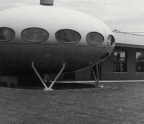
In late 1876, a nineteen-year-old Danish farm laborer named Soren Jensen Uhrenholdt enrolled in a folk school in northern Jutland, Denmark. Although the young man had spent limited time in classrooms, folk schools or “peoples’ high schools” had no admission standards or entrance examinations. Instruction concentrated on life skills, civic education, and personal empowerment. Uhrenholdt spent two Scandinavian winters at the residential school. The experience seems to have bolstered his confidence and imbued in him an optimistic outlook on life.1
Uhrenholdt may have been introduced to the ideas of Hans Bjerregaard (1766–1860) at the school. The Danes had long struggled to farm along the storm-lashed western coast of Jutland. Bjerregaard, a pastor, suggested an alternative: plant trees—millions of conifers—on the rugged heath. The reforestation strategy eventually achieved widespread support, sanctioned and promoted by the Danish government.2 Bjerregaard’s methods guided the young Uhrenholdt after he emigrated to America and settled in northern Wisconsin. Uhrenholdt enjoyed reciting Bjerregaard’s Danish verse:
Where the plough can’t go,
And the scythe can’t sing,
A tree should grow.3
Uhrenholdt’s decades in Sawyer County, Wisconsin, mirrored the experiences of thousands of small farmers across the northern Great Lakes cutover region, where vast tracts of white pine were replaced by fields of stumps during the late nineteenth century. These farmers endured hardship and privation, a taste of prosperity during the Great War, and then the long agricultural depression of the interwar years. Many of the region’s farms ultimately failed, but Uhrenholdt’s deft stewardship of field and forest made his homestead prosper. The viability of the farm rested upon growing crops suitable for the north country and practicing sustainable forestry, a blended approach that he shared with hardscrabble farmers and the faculty of the University of Wisconsin Extension. Eventually, state government officials and university leaders recognized the immigrant’s achievements. Moreover, Uhrenholdt’s influence redirected the life of a seasonal farmhand, Sigurd Olson, who developed a greater appreciation of the north country under his guidance. Olson, who married Soren’s daughter Elizabeth, would become a nationally known nature writer and conservationist. Thankfully, the story of the Uhrenholdt farm can be unraveled through detailed records amassed and translated by family members. Spanning almost 150 years, the historical documentation is today preserved by the Wisconsin Historical Society.4

Soren Uhrenholdt was born in 1857 to a single mother in the village of Borup, near Aalbord, in Jutland. The rigid and rank-bound character of nineteenth-century Denmark must have been challenging. So too was the economic flux of Soren’s youth. Rapid mechanization and global agricultural competition, particularly a surplus of imported grain from North America and Russia, resulted in economic uncertainty and migration of laborers and young people off farms across Scandinavia. Raised by his maternal grandmother, Soren’s earliest farm chores involved tending domesticated ducks and geese. By age ten or eleven he was watching over cattle and sheep in a meadow adjacent to a private forest with a meandering trout stream. The woodland’s allure occasionally led Soren into youthful trespassing, despite the risk of being caught by the landlord’s wardens. Angling for trout was strictly prohibited except for the privileged classes. Irregularly, Soren attended a primary school during the winter months.5
After attending the folk school, Soren found work on a farm in southern Demark far from his home village. In 1881, a few days after the (the Danish midsummer festival), he attended a country wedding and encountered Christine Thorn. The daughter of a prosperous bank manager, Christine was unhappily fulfilling a family pledge: cooking, cleaning, and caring for an aged uncle in poor health. Both twenty-three, Soren and Christine danced in the soft northern light of early summer. They began courting through correspondence. Christine also began keeping a diary, opening with: “I




